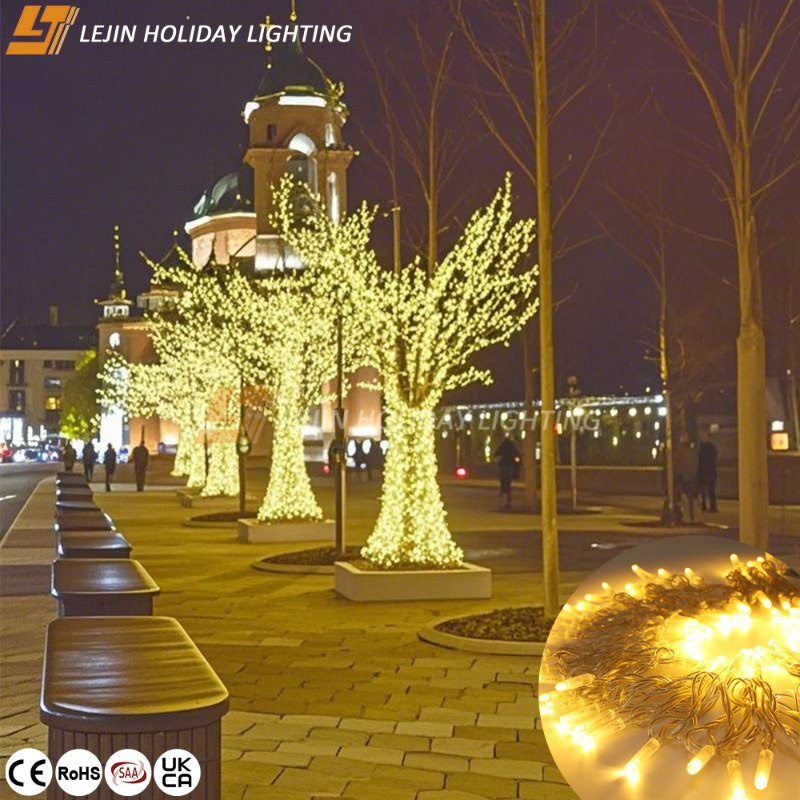A Big Comparison of Decorative Lighting Types: Core Differences and Functional Positioning of String Lights, Curtain Lights, and Icicle Lights
Though all belonging to decorative lighting, string lights, curtain lights, and icicle lights have distinct design logics and presentation effects. String lights, featuring multiple small LED bulbs connected by a single flexible copper wire, can be freely bent, wrapped, or knotted, focusing on "linear atmosphere outlining" to flexibly adapt to various irregular scenes. Curtain lights adopt a structure of a main light strip plus multiple branch strips, with bulbs evenly distributed to form a large-area light and shadow surface in varying single-panel sizes, excelling at creating immersive background effects. Icicle lights feature a structure of a main cable plus multiple hanging branch strips of different lengths, with bulbs arranged at intervals along the hanging lines, boasting a natural flowing hanging feel. Their core advantage lies in shaping three-dimensional layered light and shadow. These three types precisely match the decorative needs of different scenes from the three dimensions of "linear outlining," "planar spreading," and "three-dimensional hanging."
String Lights: Versatile "Basic Ambiance Essentials" – Applicable Scenes and Matching Tips
String lights have become the "all-rounder" in decoration thanks to their high flexibility, fitting scenarios covering home corners, commercial displays, outdoor decorations, and more. In home settings, fine copper wire string lights can be wrapped around the branches and leaves of window plants; warm yellow light filters through leaf gaps onto the desktop, creating a cozy and healing corner atmosphere. For holiday decorations, waterproof string lights can wind along stair handrails or form heart, circle, or other patterns on door frames. Paired with Christmas-themed pine branches and colorful baubles during the Christmas season, they instantly enhance the festive vibe. Matching tips: Dense bulb styles are suitable for highlighting small objects, while sparse bulb styles work better for large-area spreading to avoid overly harsh light.

Curtain Lights: Large-Area Light and Shadow Makers – Scene Adaptation and Installation Key Points
Curtain lights are "ambiance magicians" for large spaces, especially suitable for areas needing enhanced visual impact, such as walls and shop windows. In bedrooms, installing LED curtain lights on the headboard background wall with warm white light mode allows them to replace the harsh main light before bed, creating a soft sleep-aiding atmosphere. In commercial scenes, shops with remote-controlled outdoor curtain lights in their windows can set low brightness as background decor during the day and switch to flashing modes at night to attract passers-by, improving display effects when paired with product displays. During installation, measure the installation area in advance to ensure the light body fully covers the target area. For outdoor use, be sure to choose models with waterproof certification and secure the corners with expansion screws to prevent shaking during windy or rainy weather.

Icicle Lights: Dynamic Hanging Appeal Full – Scene Adaptation and Style Matching Guide
The unique charm of icicle lights lies in the dynamic light and shadow effects brought by hanging lines, making them ideal for scenes needing "fluidity" and "layered sense." In outdoor decorations, long icicle lights installed on balcony railings look like glittering icicles in winter under cool white light mode, or like flowing golden water under warm yellow light mode, casting staggered light spots on the ground when lit at night. Hanging icicle lights from the top beams of park corridors, the swaying light lines in the breeze create flickering shadows on the ground, becoming a popular night tour check-in spot. For style matching: Modern minimalist spaces suit LED icicle lights with cool white light and black cables; retro American-style spaces pair well with warm yellow light and white cable styles. For holiday scenes, lightweight ornaments like small bells or snowflakes can be hung on the hanging lines to strengthen the thematic atmosphere.

Scene Selection Guide: From Home Corners to Outdoor Spaces, Which Lighting Type Fits Better?
The spatial structure and decorative goals of different scenes determine the optimal lighting selection. For small home spaces, prioritize string lights – their flexible shaping takes up no practical space and can precisely illuminate local areas. For vertical structures like outdoor eaves and balconies, the hanging sense of icicle lights enhances three-dimensional layers, avoiding flat decorations. In commercial scenes, restaurant storefronts can use string lights to outline the shop’s silhouette, paired with icicle lights hanging along the eaves to highlight the store name while adding detailed beauty. Installing icicle lights at intervals along scenic trails creates light and shadow tunnels with hanging light lines, enhancing the night tour experience. For holiday decorations, adopt a "combination strategy": In Christmas scenes, wrap string lights around the Christmas tree, spread curtain lights on the background wall, and decorate the eaves edges with icicle lights – the light from the three types echoes each other to create an immersive festive atmosphere.
Avoiding Pitfalls in Purchase: Beyond Scene Adaptation, These Core Points Deserve Focus
After choosing the right lighting type, detailed parameters directly affect the user experience and lifespan. For brightness selection, prioritize warm white or neutral light for indoor decoration, as the light is soft and not harsh; for outdoor decoration, choose slightly brighter styles to ensure visibility from a distance at night with sufficient ambiance. Waterproof performance is crucial for outdoor use – IP44 waterproof-rated models suffice for semi-outdoor scenes like windowsills and balconies, while fully outdoor scenes such as open courtyards and eaves require IP67 or higher waterproof ratings to prevent circuit damage in rain or snow. Additionally, prioritize LED bulb materials, as they are not only energy-efficient and power-saving but also have a longer lifespan than traditional bulbs, reducing later maintenance costs.


